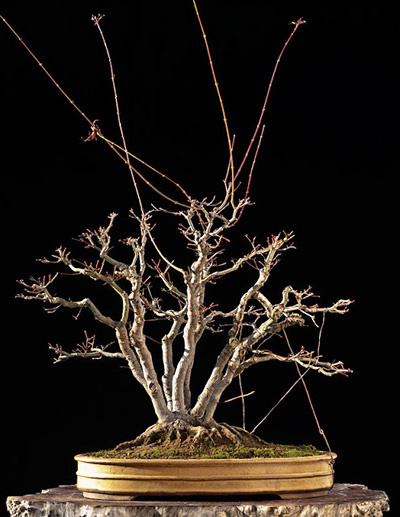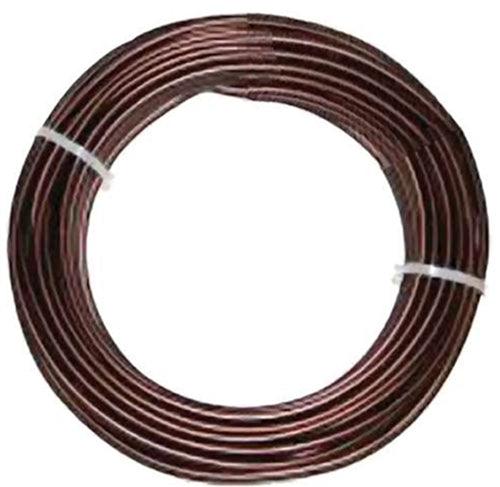Maple Bonsai Perfection
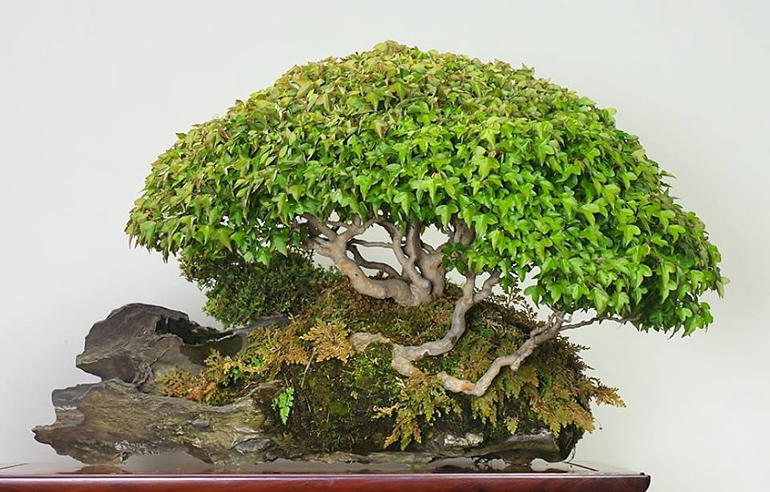
This Trident maple on root-on-rock is called Soshun-no-fu. It's estimated age is 80 years. Like the other two trees in this post it's from The Omiya Bonsai Art Museum
Lots to do to get ready for the 6th U.S. National Bonsai Exhibition (Rochester, NY, September 8th & 9th), so we’ll make this one short and sweet. All three Maple bonsai shown here are from the Omiya Bonsai Art Museum in Saitama, Japan*
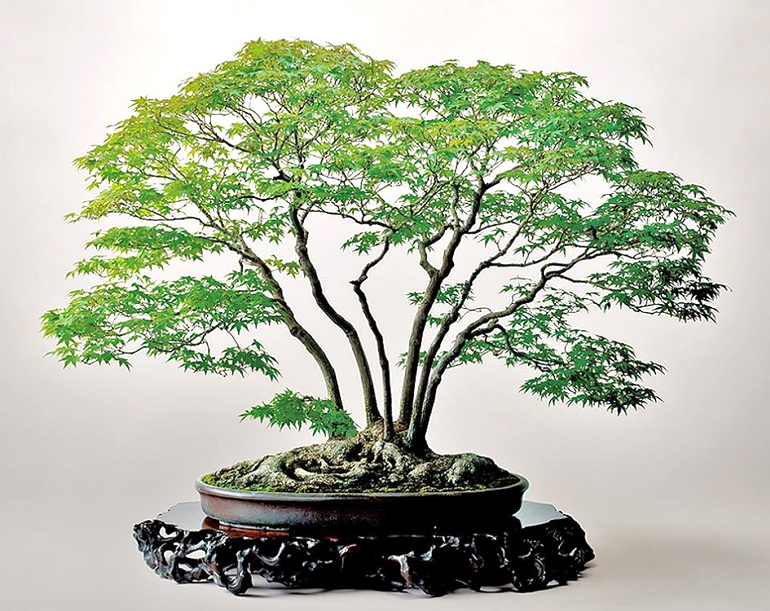
Japanese maple named Musashi-ga-oka, estimated age 150 years
Speaking of the 6th U.S. National Bonsai Exhibition, I’ve been spending time getting about 30 of our field grown American larches (aka Tamaracks) ready for the show. Almost all are in nursery containers. Some are ready to stick in bonsai pots in the spring, but many are still fairly rough stock with good potential. Ages are 15-to 22 years old. Prices will range from around 75.00 up to 750.00. I’m going to try to get a couple good photos to show you before the show, but bonsai photography is no my strong suit, so we’ll see

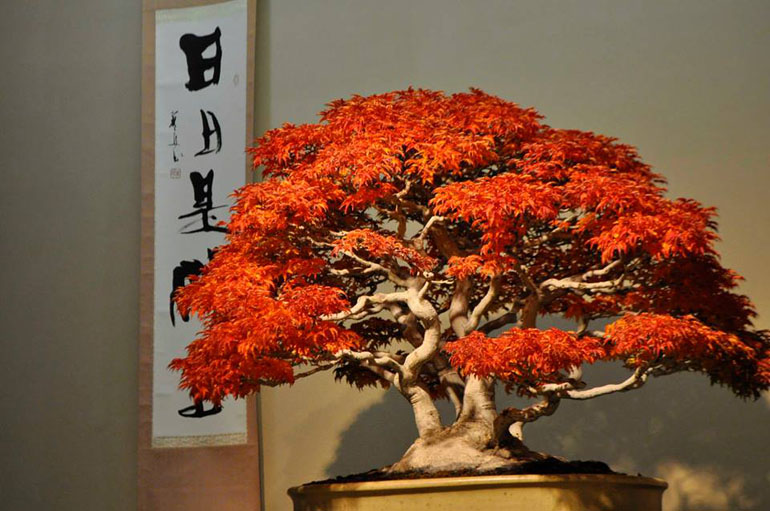
Another Japanese maple. No name given for this one, but it speaks for itself
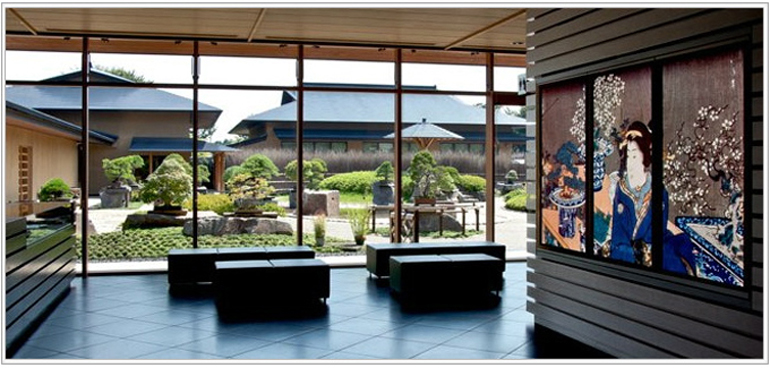
A piece of the Museum
*I found the first two photo and captions at Bonsai Master on facebook
A Bonsai in Hand – a Quick Study on Perspective
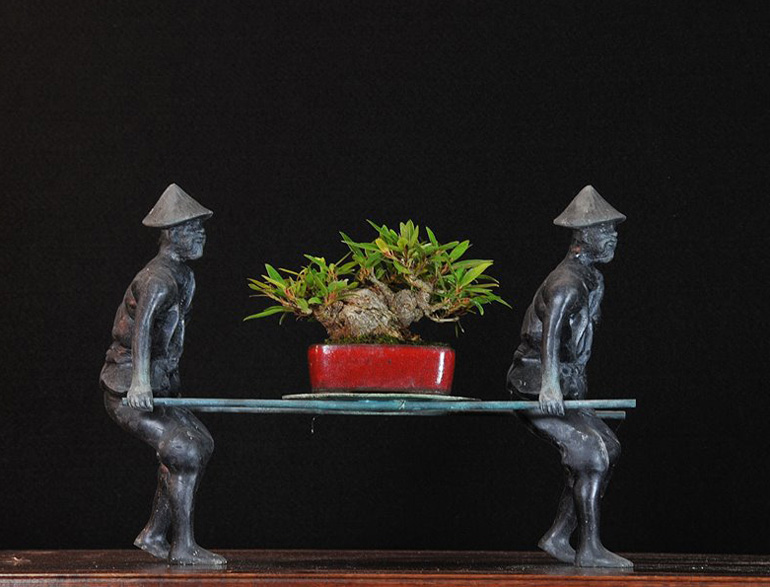
This Willow left Ficus (Ficus nerifolia) belong to Suthin Sukosolvisit. If you are familiar with this species and know something about its typical leaf size, then you may not be fooled by the presentation. However, if you aren't familiar with this variety of Ficus, you might imagine that the tree is considerably larger than it is
A study in perspective with a nod to pot color. When comes to bonsai photos, perspective can be an issue. This is sometimes solved by contrast with a familiar object. Suthin, the artist behind the Ficus shown above and below, sometimes uses a can (something I find a little distracting). Or he sometimes uses a hand (a much better choice imho). Or in the case of the photo above, an unfamiliar object that intentionally messes with perspective (I like it!).
Continued below…
–
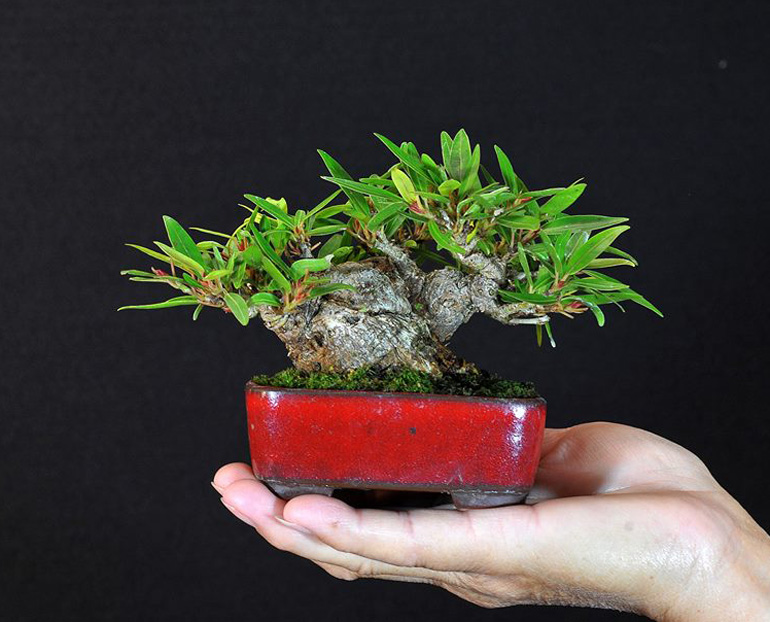
A Ficus in hand is worth two on the bench
Must be the season for red pots. Questions about the use (or maybe misuse) of red bonsai pots have come up in two recent Bonsai Bark posts
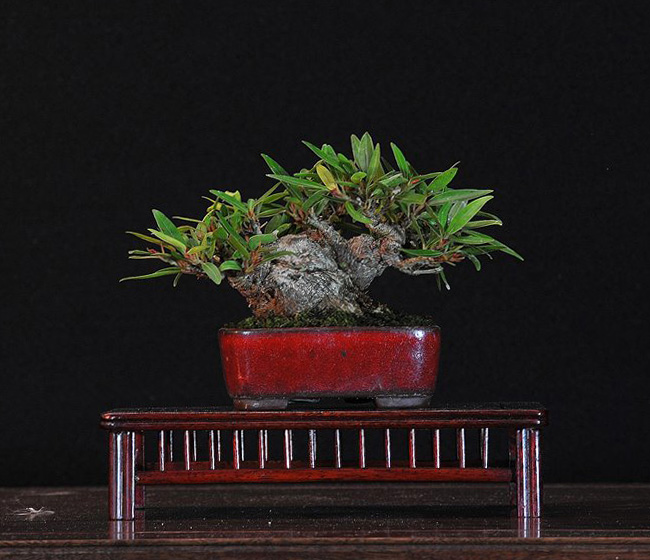
Here, perspective is provided primarily by leaf size. And because you've already seen the photo just above
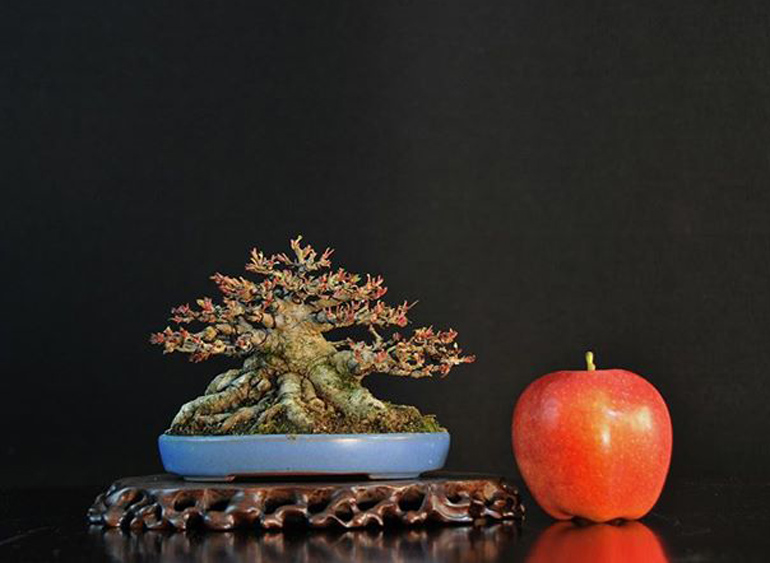
Here's something I've only seen Suthin do; contrast a bonsai with a piece of fruit. The tree is another Willow leaf ficus, but not long after defoliation, so leaf size doesn't provide that much perspective
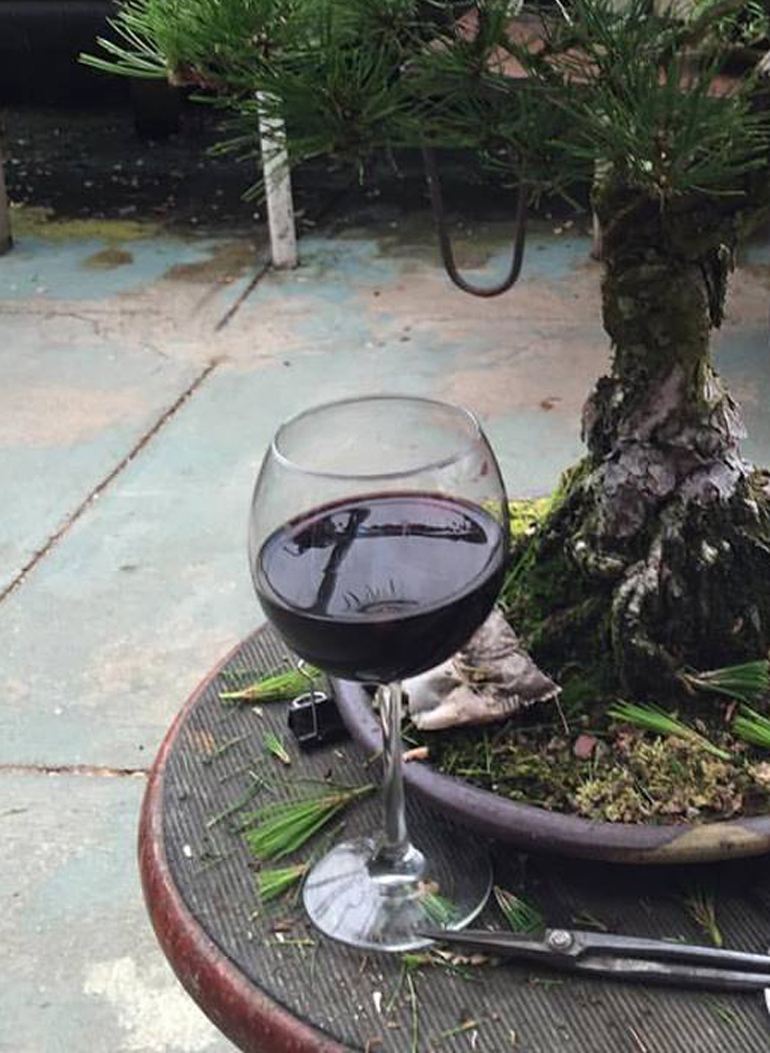
Another way to provide a little perspective. Also by Suthin
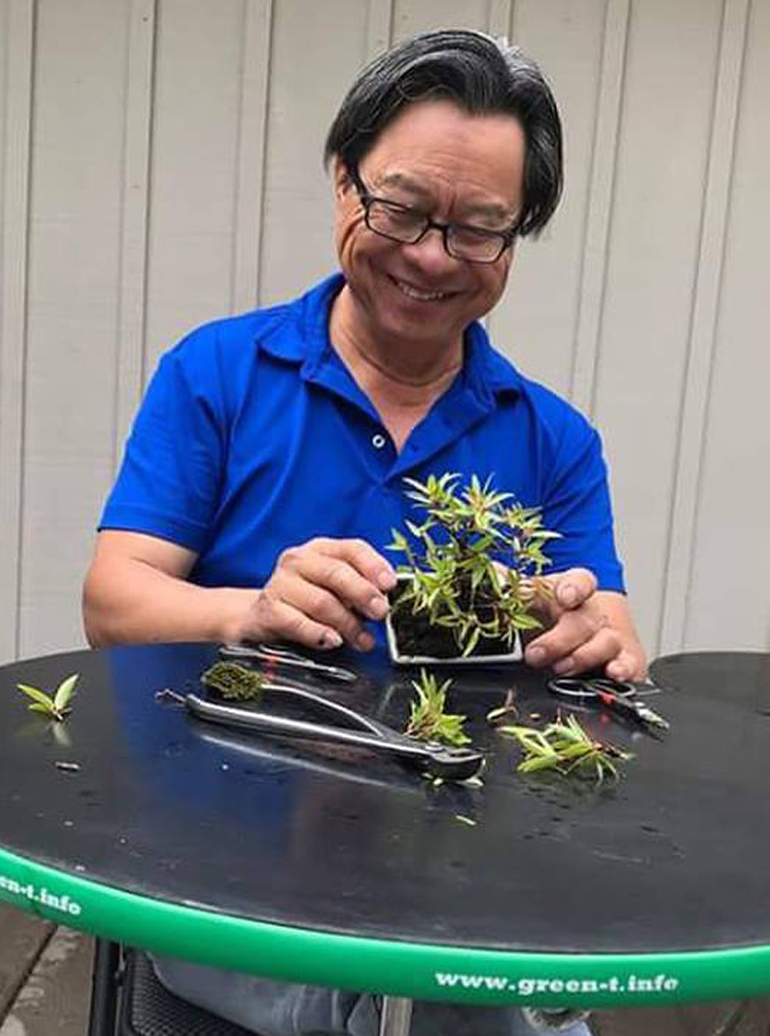
The man himself working on one of our famous Green T Turntables. The tree is... you guessed it, another Willow leaf ficus
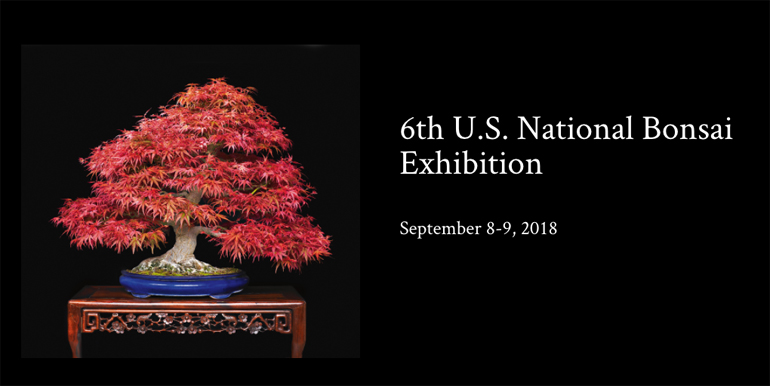
Speaking of Suthin, you can visit him and his wonderful small (and not so small) bonsai at the 6th U.S. National Bonsai Exhibition, September 8th and 9th in Rochester NY
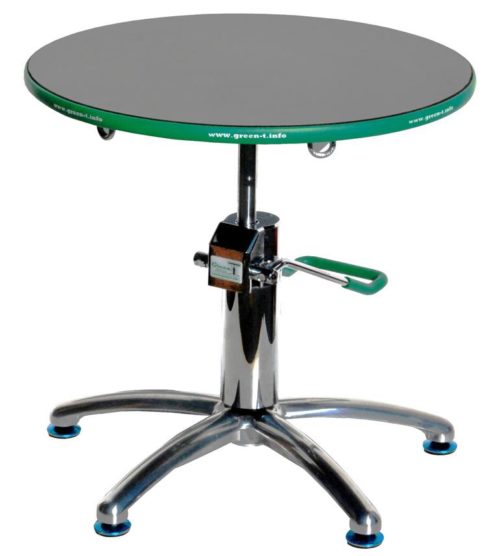
You can also visit us and our famous Green T Turntables at the 6th U.S. Including a couple slightly used ones for a nice discount. We'll also have plenty of our famous Roshi Tools, Bonsai Aesthetics Wire, some of my field grown Larches, lotsa used and new Bonsai books and much more
Kissing the Rock
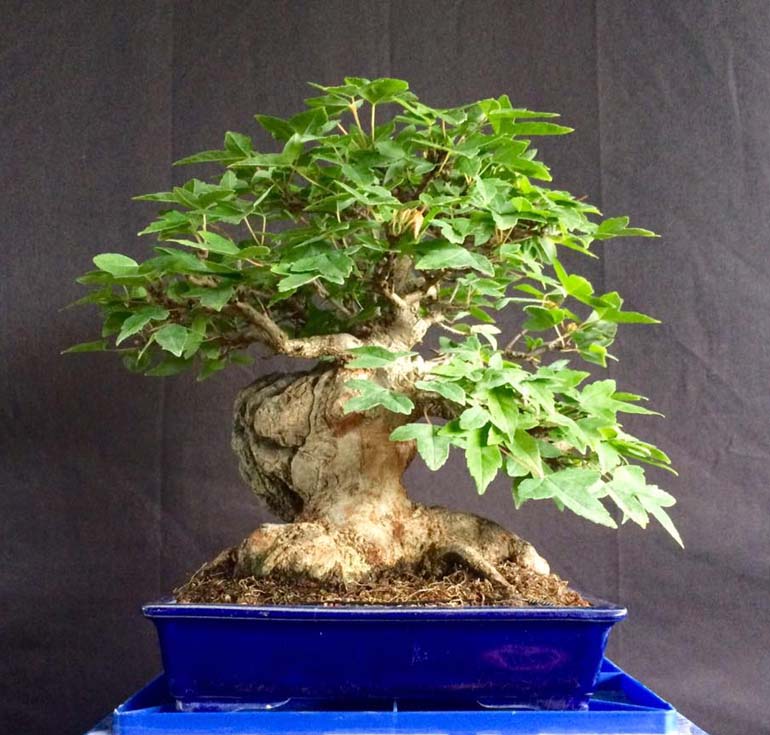
That's a rock sticking out on the left side of this Trident maple. According to Juan Andrade, the maple is kissing the rock (Arce "besando" la roca)
Continuing with the bonsai of Juan Andrade… Juan is one of a whole host of young Western apprentices (Costa Rica in Juan’s case) who are studying or have studied in Japan. This post is from our archives (July, 2017) and the photos and quotes shown here are from Juan’s timeline
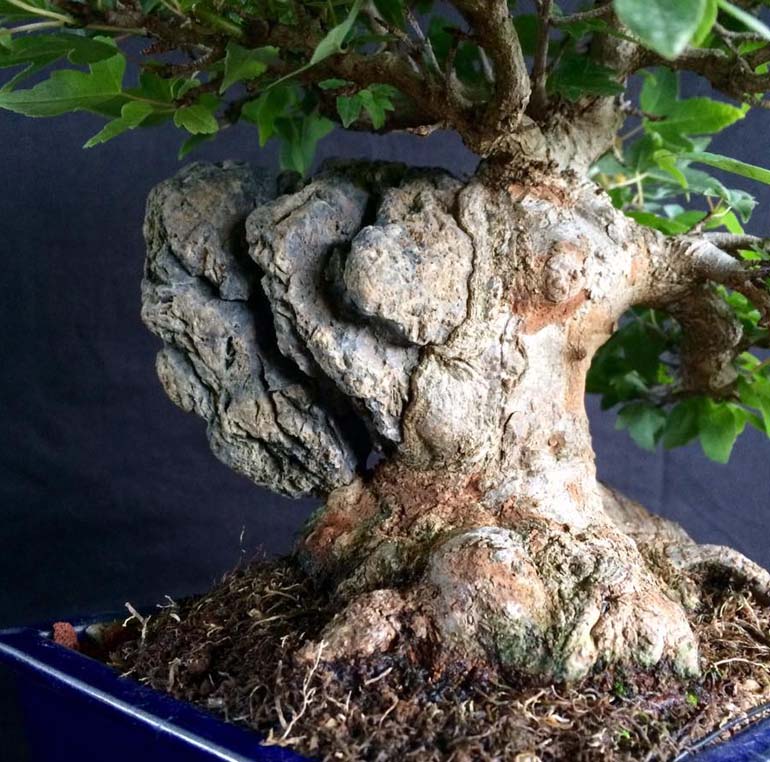
Front view, close up. Here's Juan's caption... "se planto así a propósito desde joven, y el arbol comenzó a "tragarse" la roca. Es un maplecito como de unos 50 años." And here's my rough translation... It was intentionally grown this way since the tree was young and began to swallow the rock. It's a little Maple about fifty years old
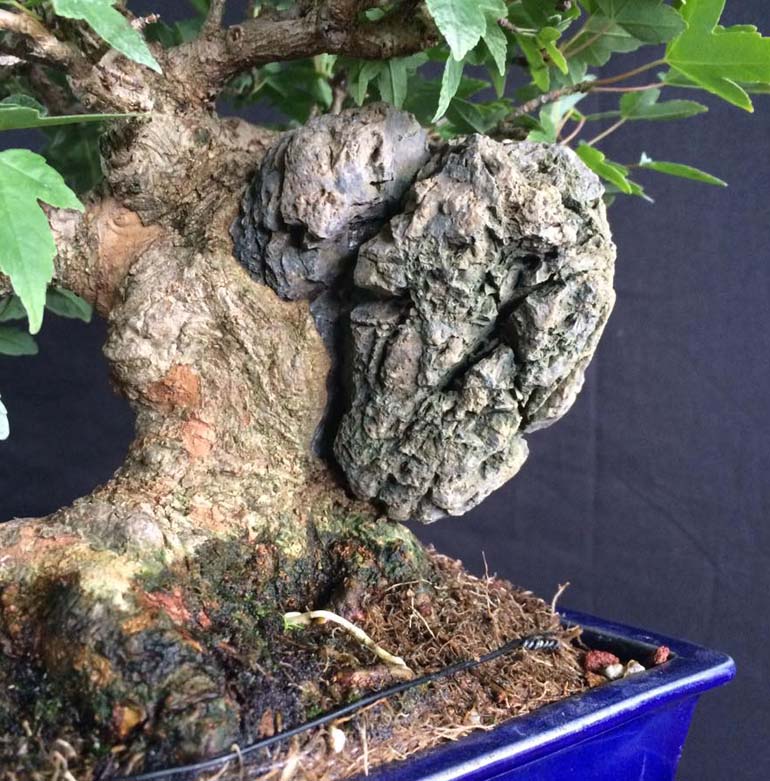
The other side
A Kimura-esque Bonsai Transformation
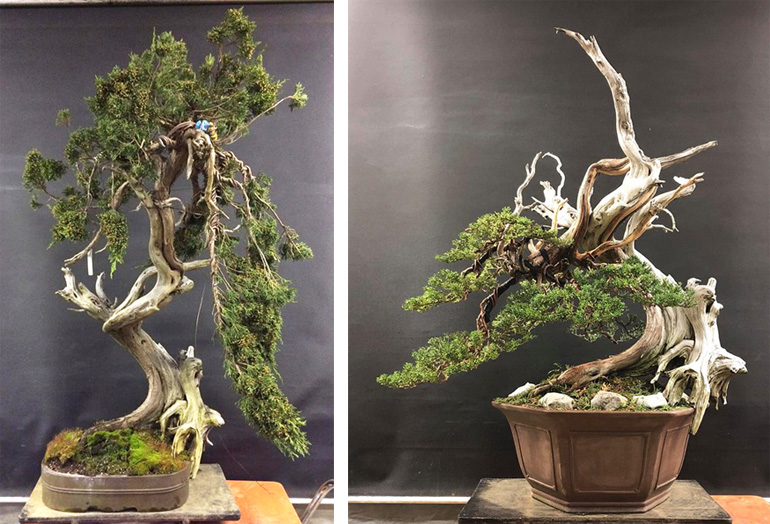
This Kimura-esque transformation was accomplished by Juan Andrade. Here's Juan's caption... "Trying to make the shortest tree you can when styling a bonsai? Hmmm ...? 2 yr. project comes to fruition at AichiEn. 2016: I bent, cutback, repotted with the assistance of John Milton and Martin Díaz. 2018: I styled after a solid growth period. I‘m still on the pursuit of happiness." Here's your link to Juan's fb timeline for more photos. BTW, Juan doesn't mention the type tree Juniper (he doesn't even mention juniper, but that part is easy)
Bonsai transformations like the one above require a high level of skill and a well developed understanding of aesthetics. Especially when the entire transformation is accomplished in just 28 months. (There’s a story about making shoji screens I once heard – almost anyone can make a shoji screen if they have enough time, but can you make one in a day?)
–
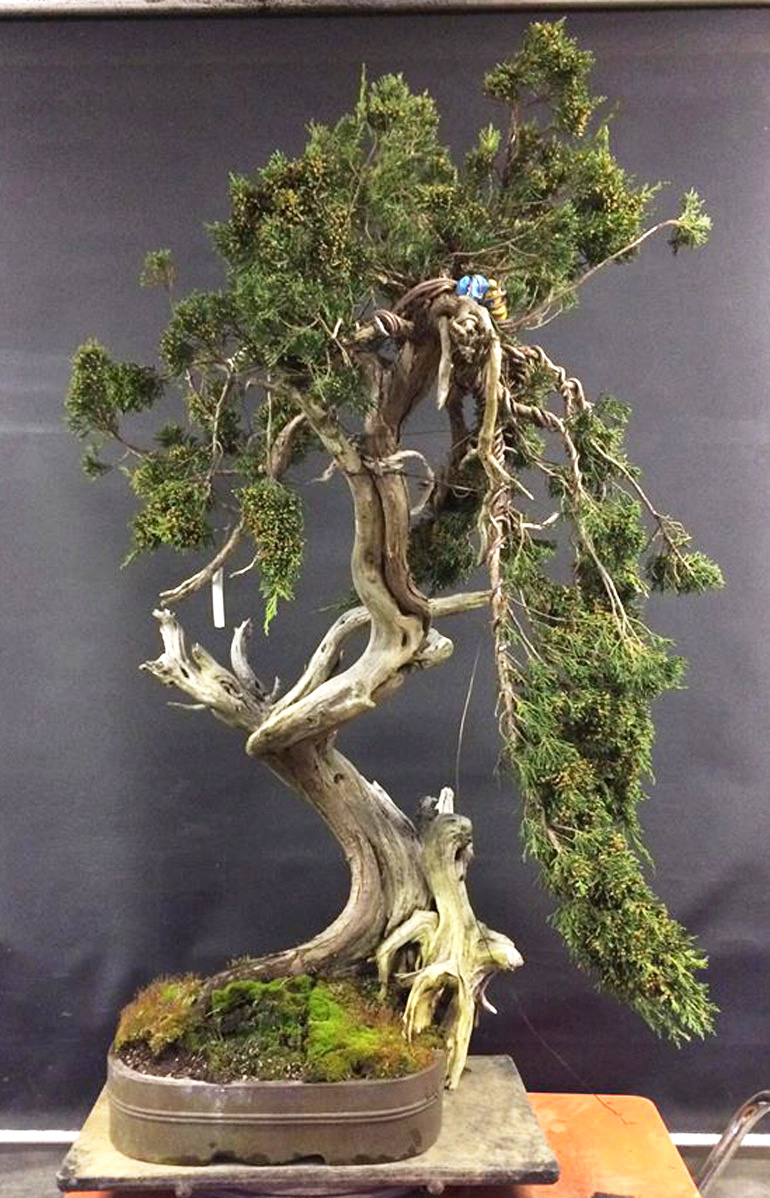
Before. April 2016
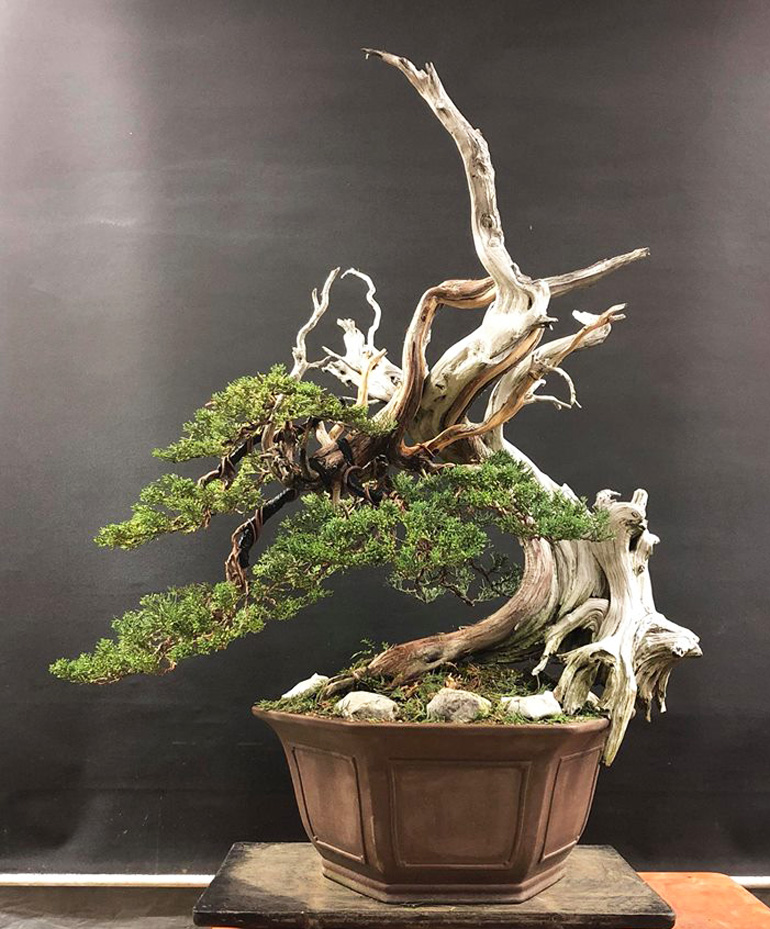
After. August, 2018. Only 28 months from when Juan started
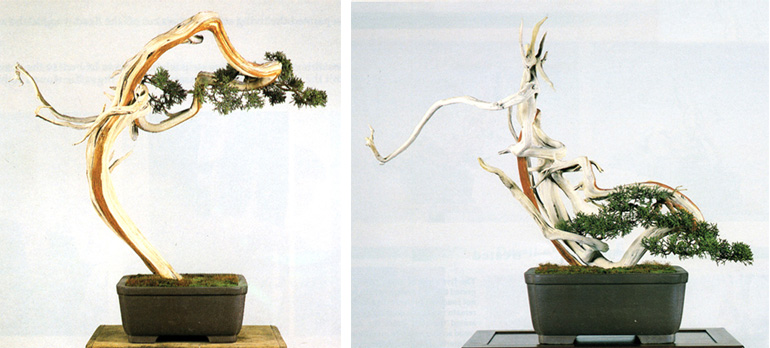
A mind bending transformation by Masahiko Kimura, the man who revolutionized Japanese bonsai. The photos are from the book, The Magician, the Bonsai Art of Kimura 2
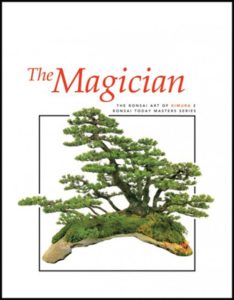
The Magician
the bonsai art of kimura 2
(Stone Lantern Publishing)
If you like radical bonsai transformations, you’ll love this book
Strolling Through Walter’s Backyard Bonsai Garden
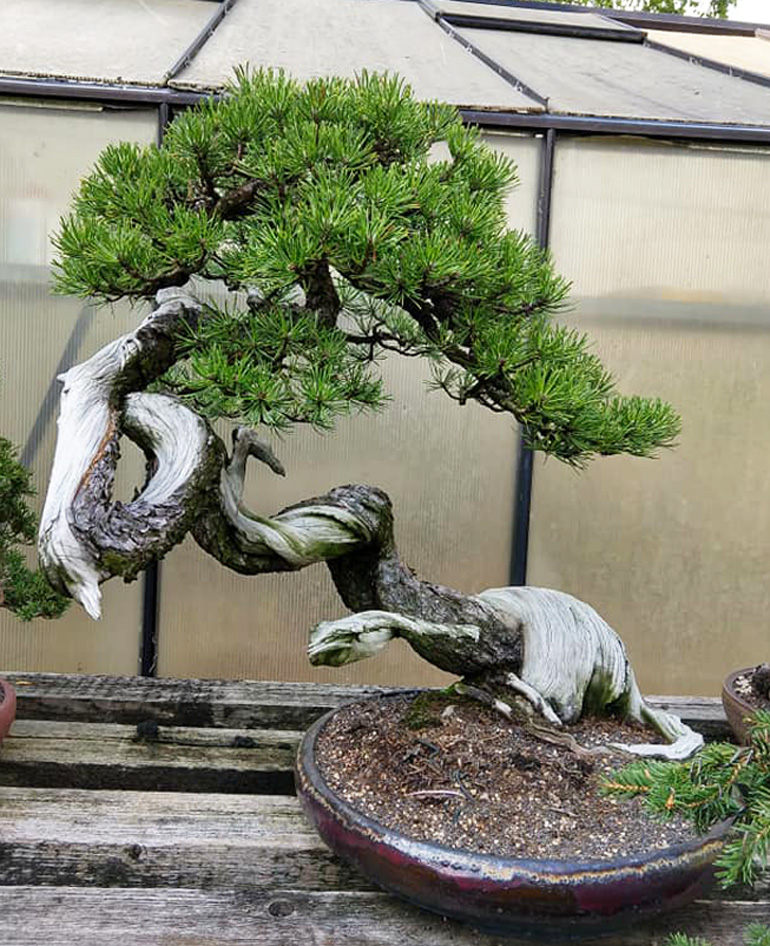
Well, we know it's a pine, but we could only guess the variety and we'll forsake guessing today (your guess is as good as mine)
Seeing the trees photographed at home on their benches is a different experience than seeing them when they are photographed in a studio setting. All the photos shown here are from Jennifer Price’s timeline. The only text provided is… “Discussing trees in Walter Pall garden today….. We’ll leave the rest to you (no guessing or researching today)
–
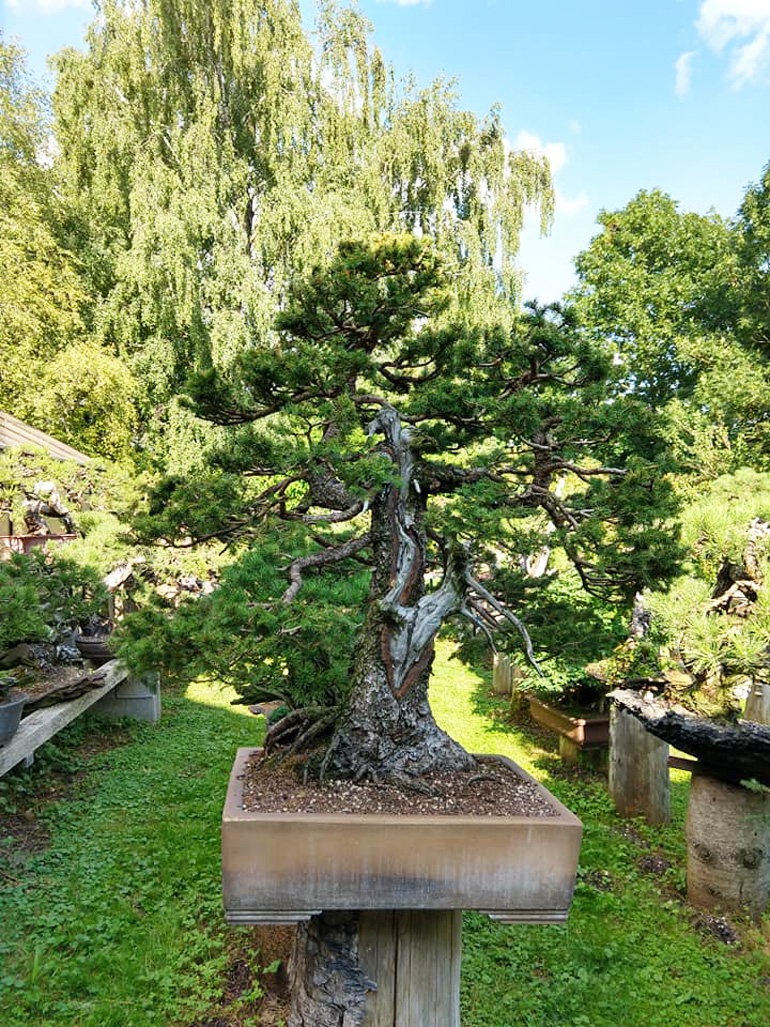
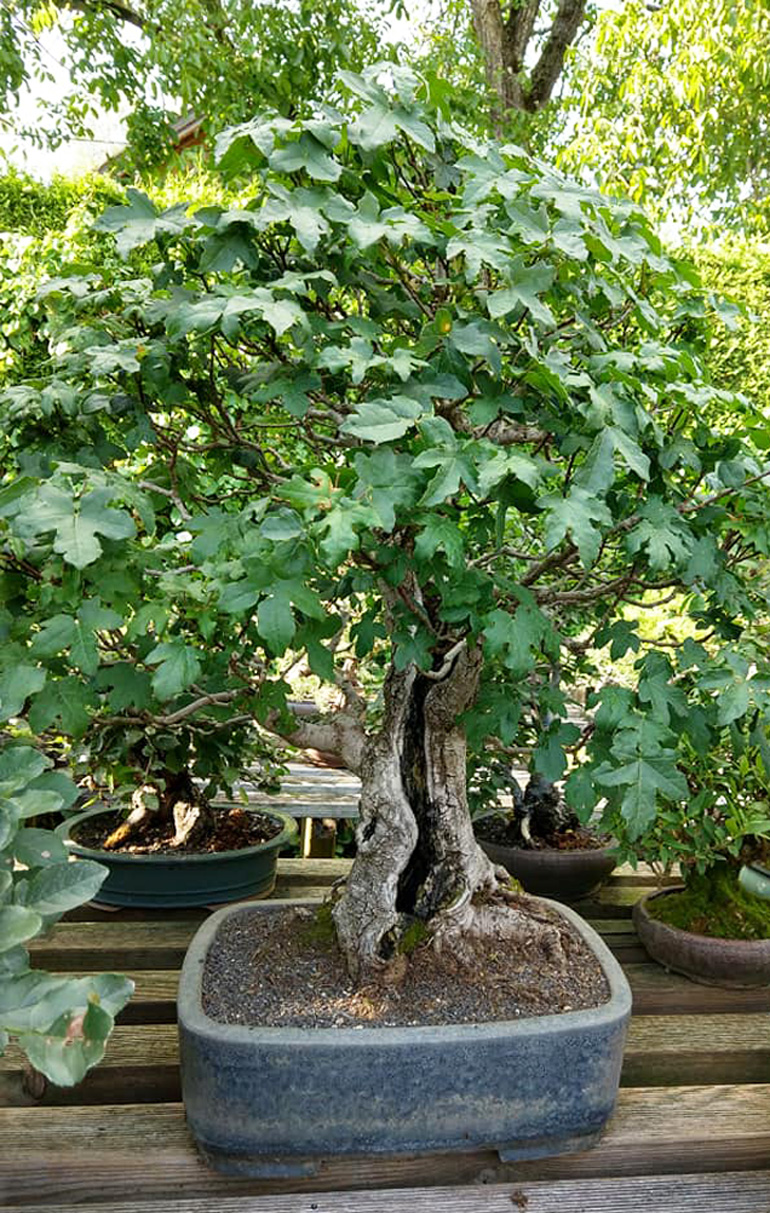
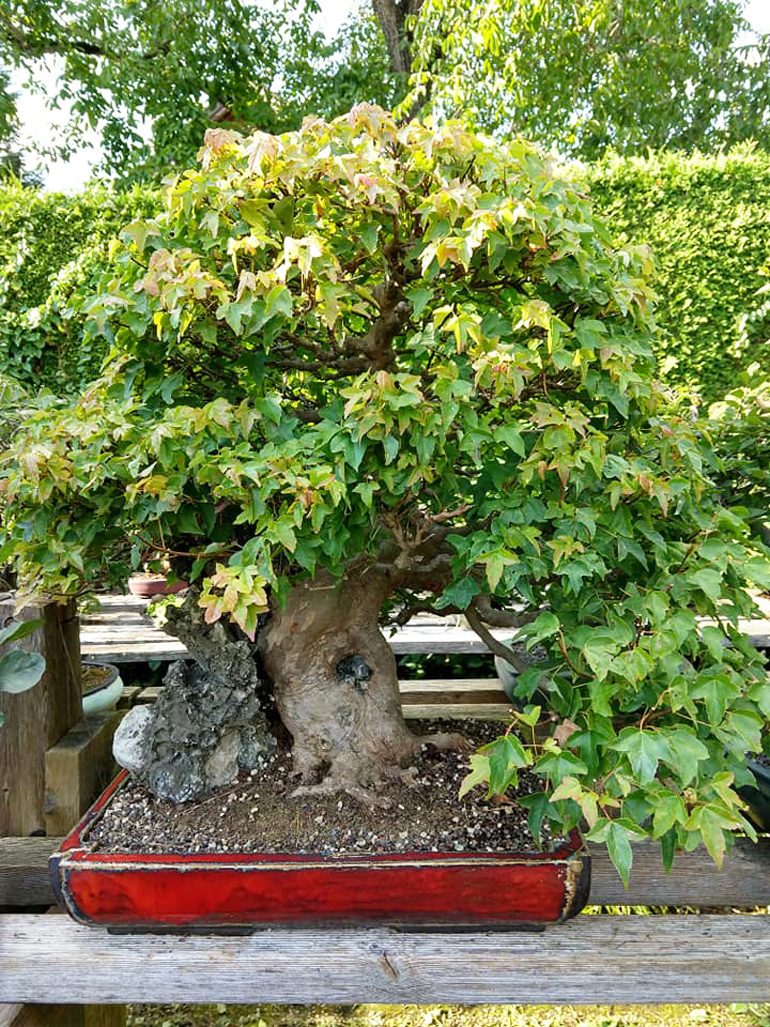
Look familiar? We featured a studio shot of this one just the other day

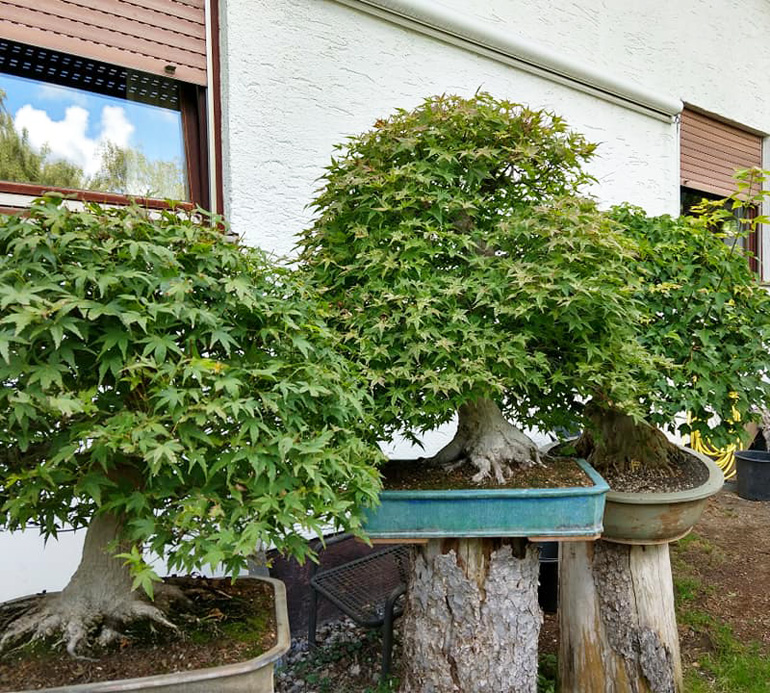
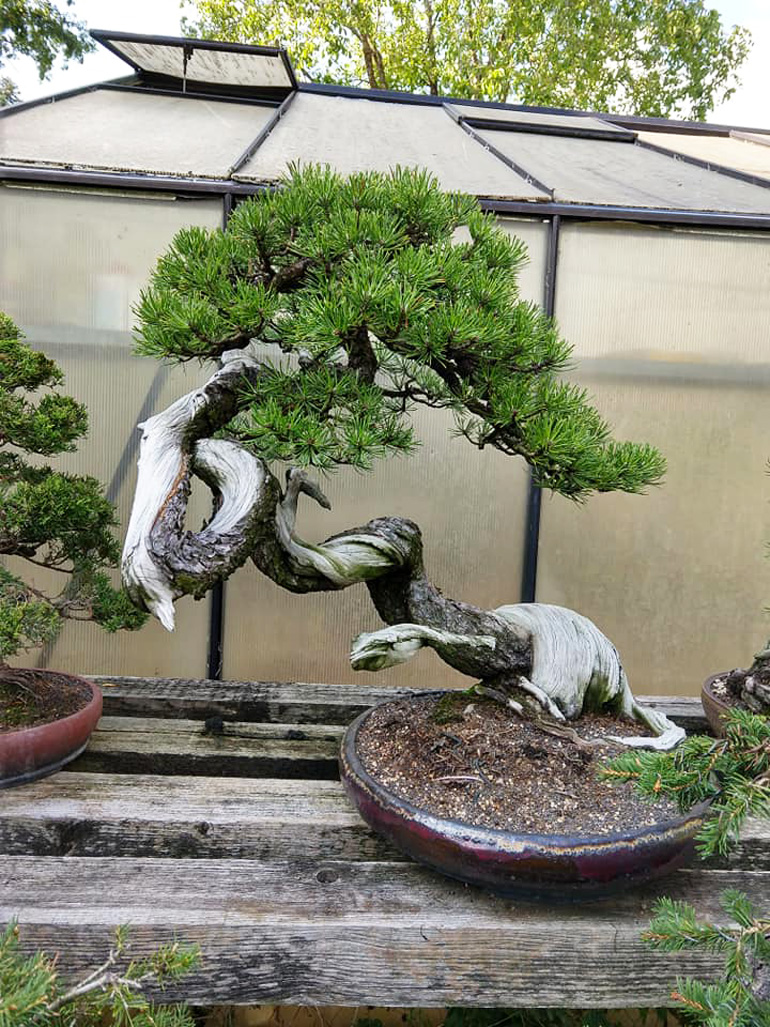
The uncropped version of the tree at the top of the post
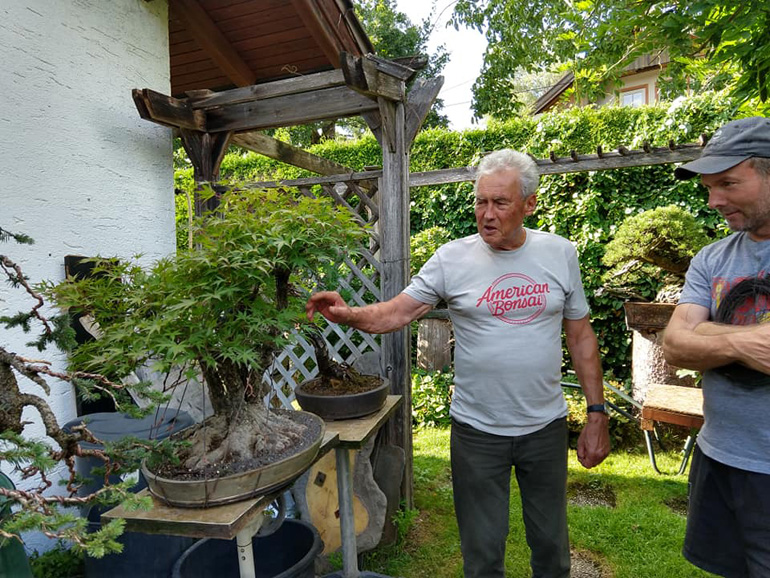
This must be part of the discussion mentioned in Jennifer's caption. That's Walter with the American Bonsai T-shirt. I don't recognize the other gentleman (maybe someone can clue us in)
Our National Bonsai & Penjing Museum, an American Treasure
This famous old Japanese white pine is one of the most powerful bonsai anywhere. You can find it at the National Bonsai & Penjing Museum. As always. the photo, though enticing, doesn't begin to do justice
Overslept this morning and then had to deal with delivery of 127 boxes of Bonsai Aesthetics wire (about 7,000 individual rolls of wire in 3 sizes: 100gram, 500gram & Kilo rolls), so we’re already way behind schedule. Time for our archives. This one is from Bark’s first month in existence (Feb, 2009)
Next time you are in Washington DC, don’t miss the opportunity to visit our exciting National Bonsai & Penjing Museum. Meanwhile, you can enjoy some of the bonsai, suiseki and other national treasures right where you are just by clicking bonsai tour.
–
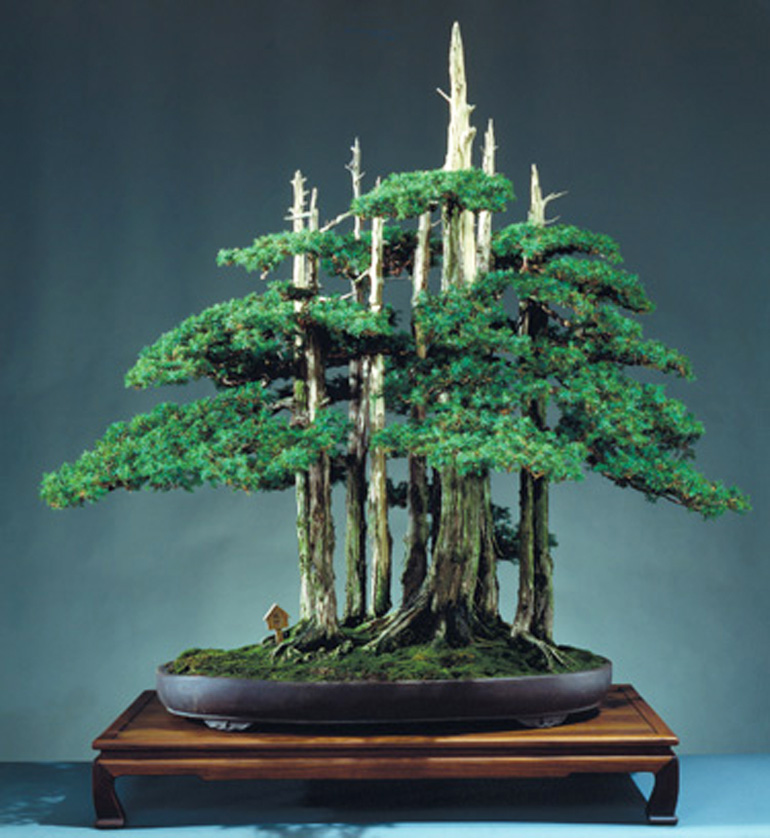
This photo of John Naka's famous Goshin was taken by Peter Bloomer. The tallest tree (all 11 trees are Foemina junipers) stands about 52" (132cm). Don't be fooled though, the photo doesn't begin to convey the power of this bonsai. This was driven home to me at the 2005 WBC Convention in DC. I was just getting my bearings when I stumbled upon it in the lobby area, purely by accident. I almost fell over. For a moment, I wasn't sure what I was looking at; it was so much larger, stronger and more vivid than I ever imagined. Now, whenever I look at a photo of a great bonsai, I remind myself that what I am seeing is a pale reflection of the real thing
Simplicity, Elegance & More than a Little Skill…
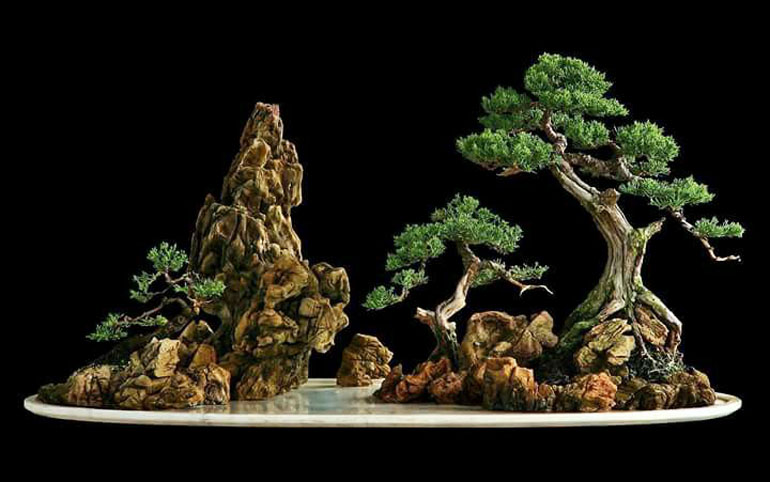
Simplicity, elegance and more than a little skill is expressed in plantings like this and the one below. Often Penjing landscapes will include a whole range of items, both manmade and natural. In this case we have only three trees and what looks like three rocks, or rock clusters. And of course the elegant long thin white penjing tray (white trays are common, especially with waterscapes)
I found the two Penjing landscapes featured here on Pham Thái Bình’s timeline. It’s not clear who the artists are, though the caption for the one above says with Dang Nguyen Van, though there are reasons to believe Dang is not the artist
Continued below…
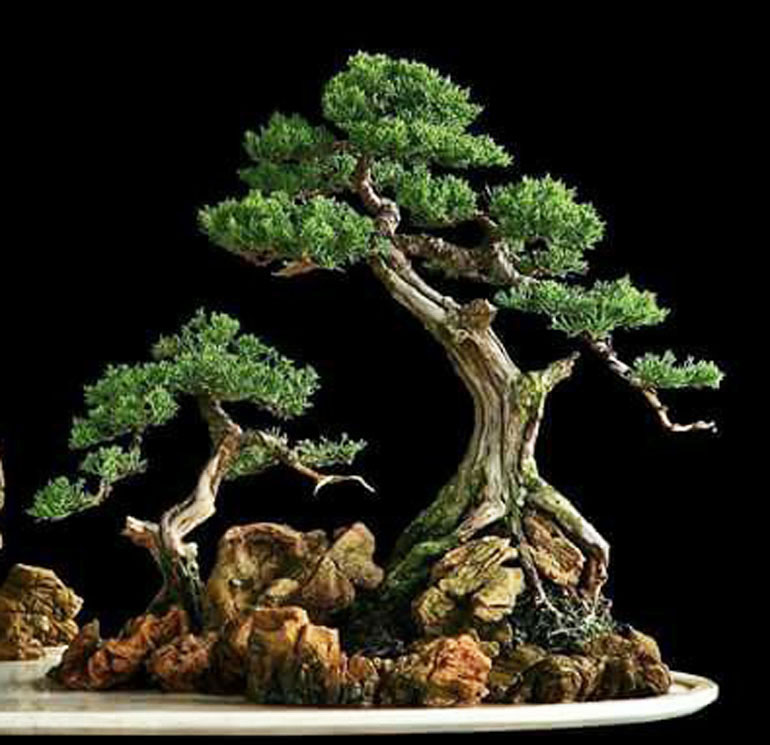
A closer look at the right side of the planting
Continued from above…
My apologies for the failure to accurately attribute, though we could ask Pham to share part of the responsibility. Pham is one of many people who posts without bothering to attribute. Normally we ignore them, but these plantings are too good to pass up, so the least we can do is to pass on our sources so that you can do your own investigating if you’d like
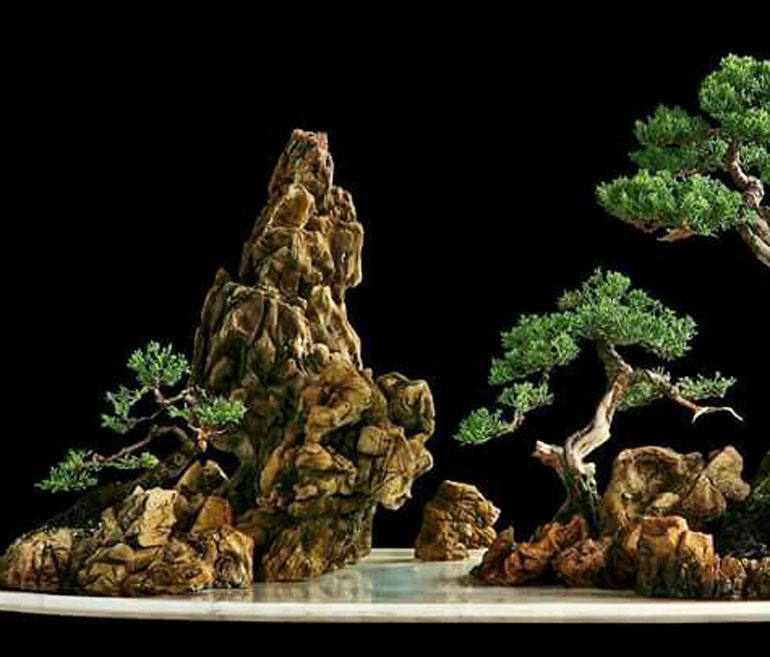
And the other side
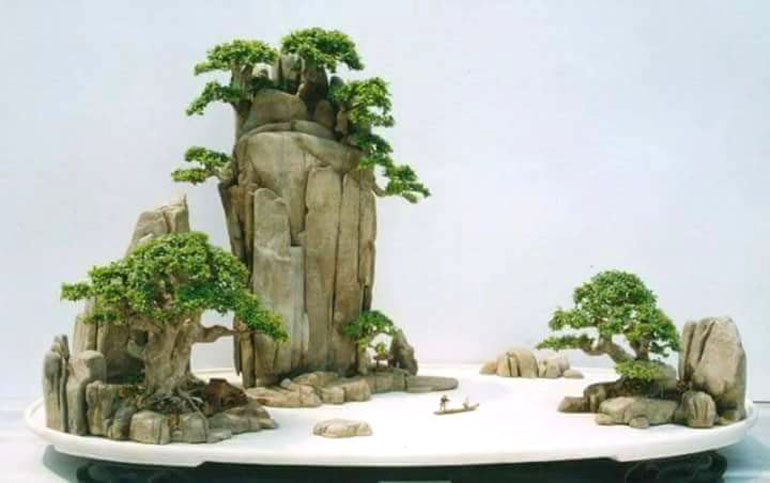
The other Penjing tray planting. More detail than the one above, but still fairly simple and elegant. And then there's that magnificent towering rock
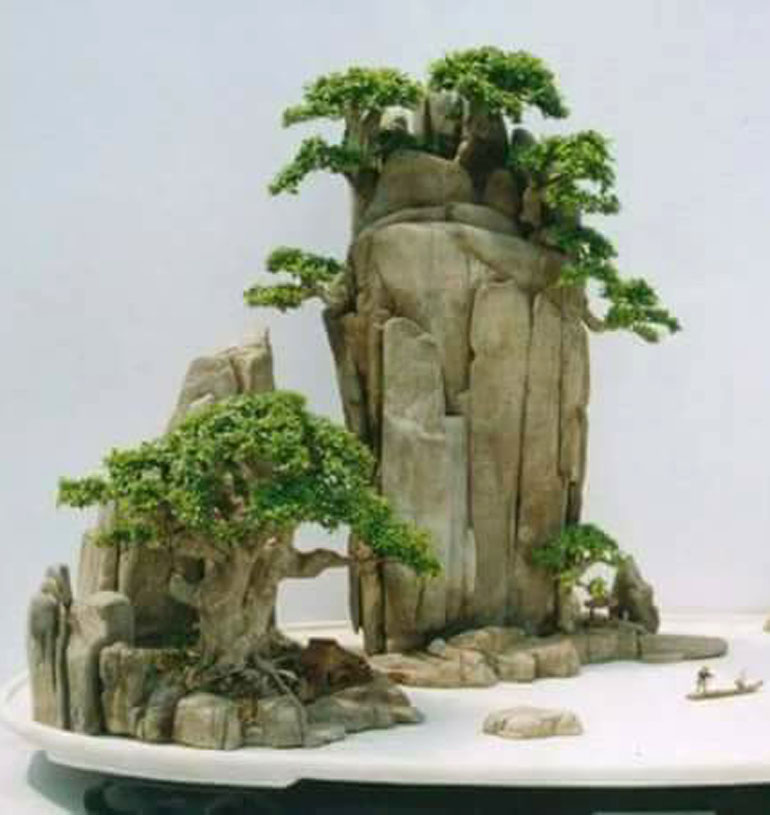
The left side. What's going on between with the little tree and rock just to the left of the man in the boat? We could try to blow it up even more for a closer look, but this closeup is already a little fuzzy, so I don't think it would work
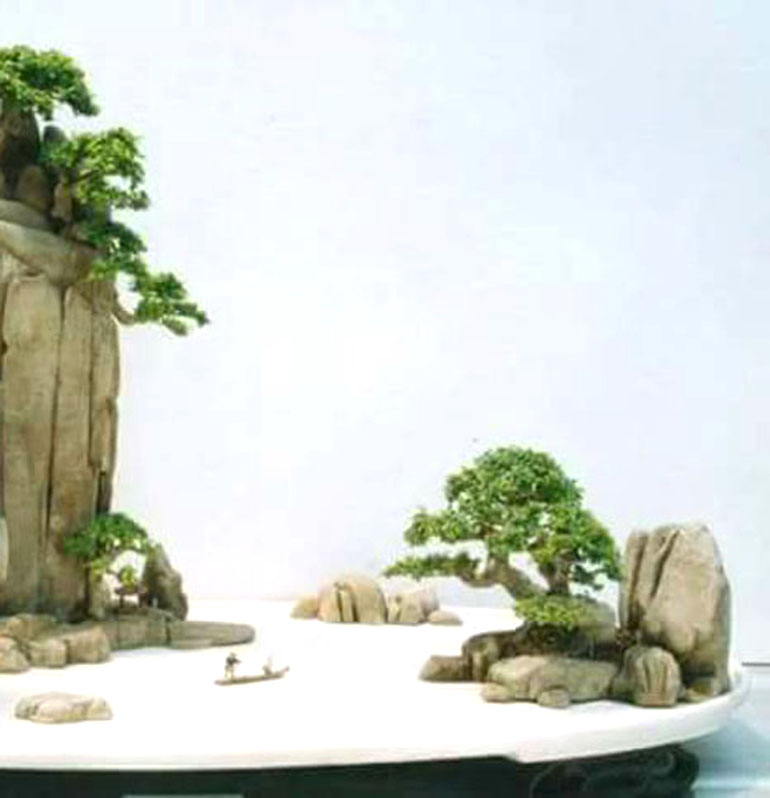
The other side
Bill Likes Red Pots Too!
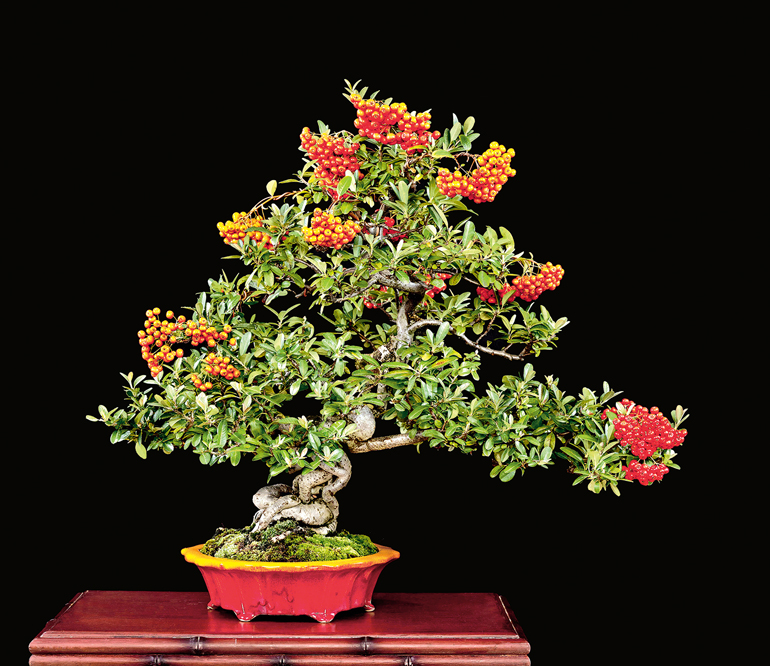
Red berries, red pot. Or maybe more accurately, orange berries, red pot (colors vary from screen to screen, so it's hard to tell). The tree is a Firethorn (Pyracantha) that belongs to Bill Valavanis. Bill sent it to us with the line I LIKE RED POTS TOO!, in response to a post we did a couple days ago that was titled, Red Bonsai Pots, a Shift in Taste
As long as we’re featuring Bill… The 6th U.S. National Bonsai Exhibition is less the four weeks away. This monumental Bonsai extravaganza is without a doubt, THE North American Bonsai event and it only happens once every two years, so best not to wait. There’s still time to make your plans and book you flight or fill you tank for the journey. You’ll be happy you did

Sign up now for the 6th U.S. National Bonsai Exhibition
Rochester NY, September 8th and 9th
Bonsai Hedge Cutting Method
The Japanese maple that Walter Pall uses to illustrate his 'hedge-cutting method.' This photo was taken four years after Walter started working with this tree. The before photo is below
Continuing with Walter Pall… we originally ran this post on Walter’s hedge-cutting method in 2013, but it’s so good that it’s worth another look
I first learned about hedge shearing bonsai from Jim Smith (sadly now deceased), a highly respected American Bonsai Artist and grower who worked primarily with tropical and sub-tropical bonsai. Because Jim lived in Florida, I figured that hedge shearing was only used in the tropics or sub-tropics, due to rapid rates of growth and recovery
That was until I began field growing larches here in Vermont and decided that the only way to keep up is to use my sword shears (large one-handed shears with long blades that I originally learned about from Jim) and simply keep cutting back to the desired silhouettes (while letting some lower branches grow unrestrained for a while, in order to create taper). At least while they’re in the ground. However, until we originally posted this (2013), I didn’t know about Walter Pall’s hedge-cutting method, which as it turns out is considerably more detailed and sophisticated than mine.
–
–
Before
Quoting directly from Walter… “2008-05: The tree arrived in my garden in this state. The previous owner had kept it in Akadama mush and thought that he would automatically improve the tree by pinching. The crown is much too wide and flat and the leaves hide poorly structured branches. Many branches are dead. The Nebari could be much better and the maple is planted too high in its pot.”
“Well, a few decades ago when the first bonsai trees were brought to the West, the purchasers asked how they should care for these trees. The answer was given so that no mistakes could be made. It was assumed that the owners wanted to keep the trees in the state in which they purchased them. The pinching was recommended because it is useful for trees that are ‘finished’ and ready for exhibition or sale. Nobody thought at that time that the Westerners would ever be able to develop bonsai themselves.
“In the developmental phase, the goal is clearly to improve the tree. The trunk and the branches must be thickened, pruning wounds must close and the tree is to develop so many new shoots that one has a choice of useful branches. The nebari should also improve significantly. At this stage, the immediate image is secondary to the future beauty. That is why leaves can be large and the tree can look ugly for the longest time. To achieve these goals, the tree needs as much excess energy as possible which it can only obtain through the photosynthetic activity of as many leaves as possible. If exactly those sources of energy are removed too early, then the tree can’t develop. In the worst case, it dies a slow death.”
As you can tell from the sacrifice branches, Walter's methods involve more than just hedge shearing
Walter continued from above…”2009-01: A deciduous tree can be much better evaluated without its leaves. It is now apparent that the center tree ought to be much thicker and somewhat higher. The previous owner didn’t achieve much by many years of pinching. It looks rather poorly developed. The pot by Bryan Albright seems over powering.”
“The numerous leaves produce lots of energy in the form of carbohydrates that moves downwards through the branches and is deposited in the branches, the trunk, and finally the roots. The result is that branches and trunk thicken, that the surface roots – the nebari – also thicken, and that the roots grow strongly. At the same time, many new visible and dormant buds develop. The entire system “tree” is strengthened and it has good reserves for any setbacks. A radical cutback is such a setback.
In Central European climate about six to eight weeks after the first flush, in our area from the middle of May to the beginning of June, the tree is then cut back with big sheers to its previous silhouette. It is irrelevant where exactly it is being cut, or if any leaves are cut. This actually ought to occur as a partial leave pruning will allow light and air into the crown of the tree. All other growth inside the silhouette is not touched but strengthened with this method. And the tree is strongly encouraged to bud out again.”
The final photo in Walter's article
Walter continued from above… “2013-02: The tree was repotted into a very suitable pot by Walter Venne from Germany. The results of the development thus far are quite presentable. But is is by far not the end of the development. Much has changed in five growth periods, yet the work continues as before. In another five years the tree will be better again. The drawback, however, will be that he tree is not really presentable during much of that time.”
The above comments and photos are just a sampling from Walter Pall’s ground-breaking article on his hedge-cutting method.
The following photos are not by Walter
Our Sword shears work quite well for the hedge cutting method
Podocarpus macrophylla by Jim Smith. My best guess is that Jim used his own hedge shearing method to develop this tree. Photo is from The Art of Bonsai Project.
Red Bonsai Pots, a Shift in Taste
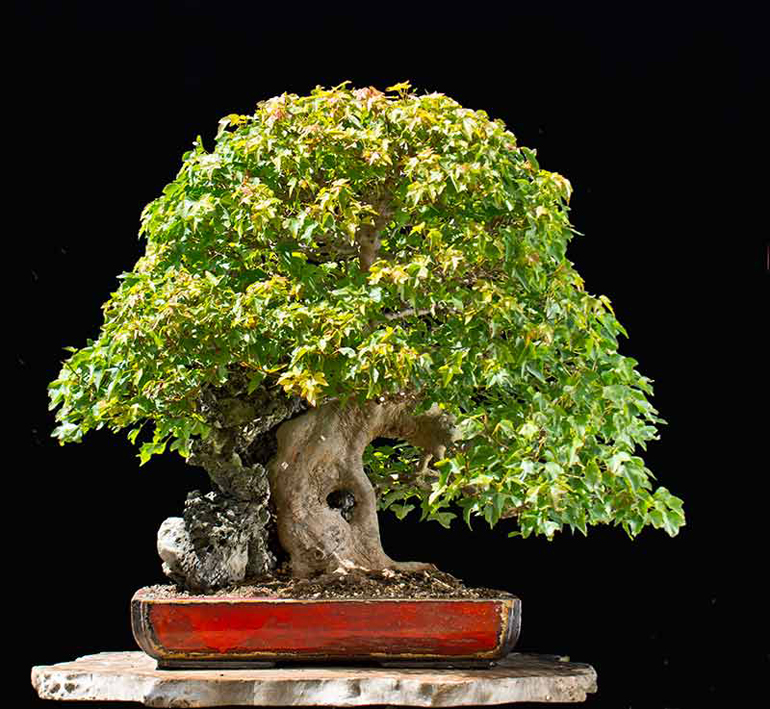
This Trident maple (Acer burgerianum) was imported from Japan in 2016 by Walter Pall. The tree is around fifty years old and about 50cm tall (20"). The pot is by Walter Venne. Here's Walter's caption... "The maple got a new pot by Walter Venne. To many this will be a big surprise. Ten years ago one could not get a red pot nor could one sell it. Now it's still very new and somehow daring to use one. In ten years it will be common. A shift in taste is going on."
Walter Pall must have one of the largest selections of imported Japanese bonsai in the world and he usually sets about upgrading each tree fairly soon after he receives it. If you compare the original photo (just below) to the other photos here, the changes are obvious.
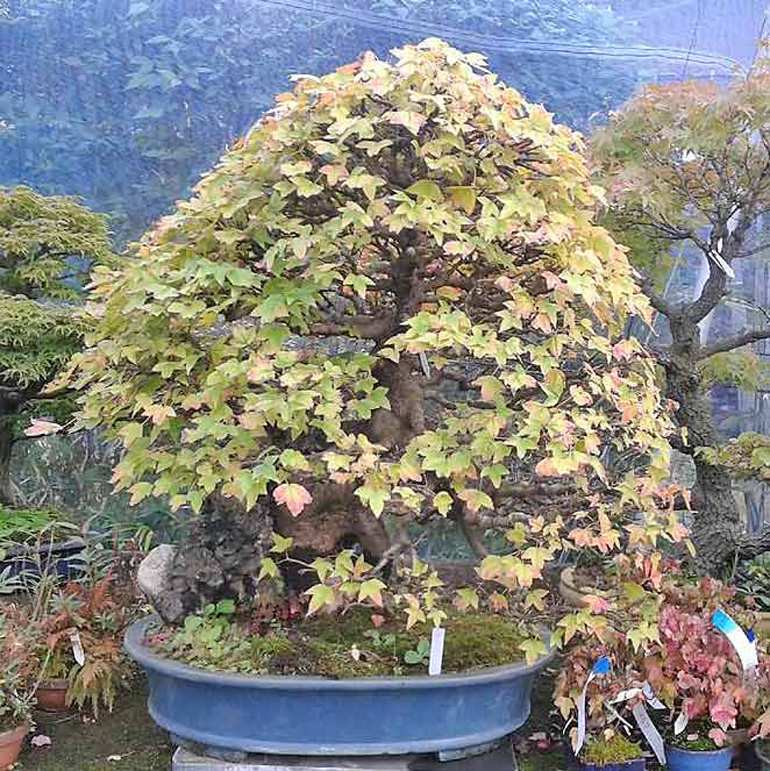
Though Walter doesn't say, you might imagine this photo was taken in Japan before the tree was shipped
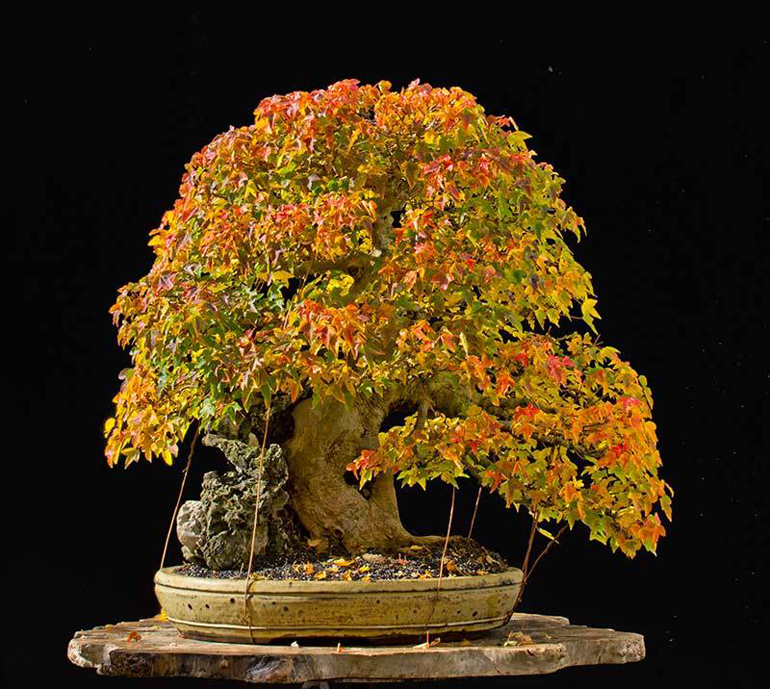
Fall color in an earlier pot. The guy wires serve to lower the the main branches. With apically dominant trees, lowering branches is usually essential if you want to create and maintain a natural aged look
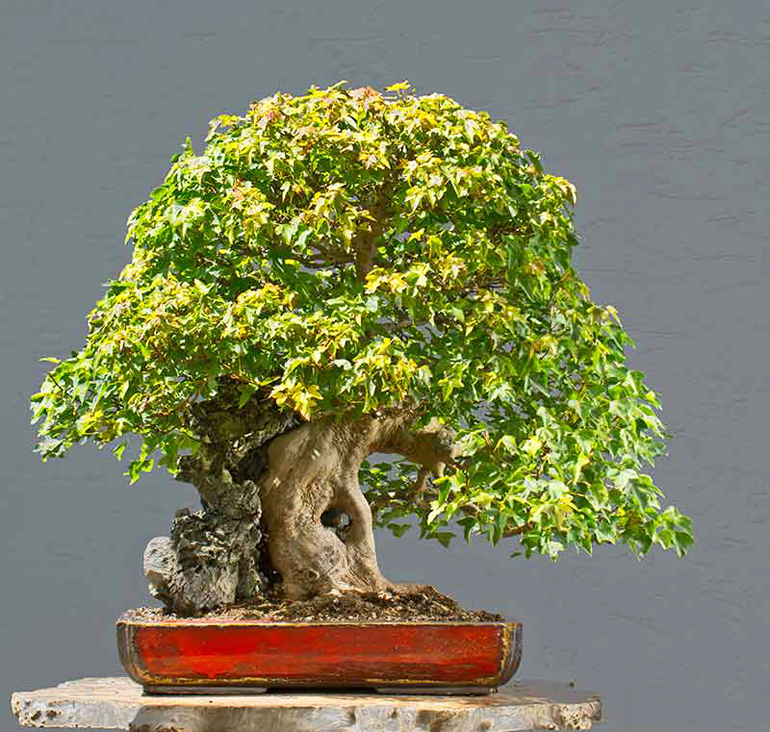
Same photo as the one at the top, but with a grey background this time. Walter usually features at least two background colors
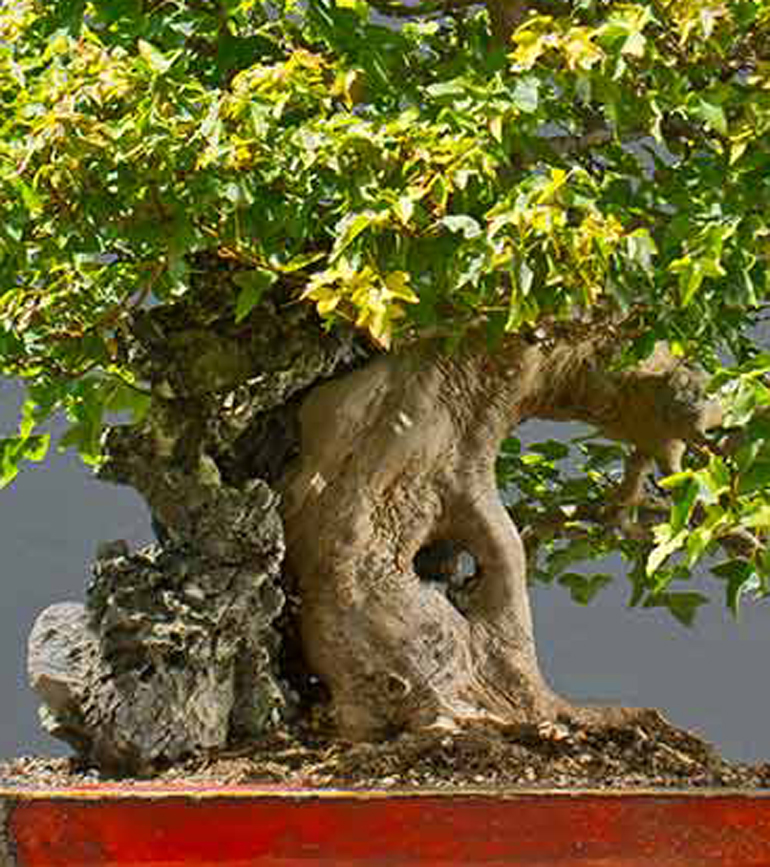
I cropped this one for a closer look at the trunk and rock

